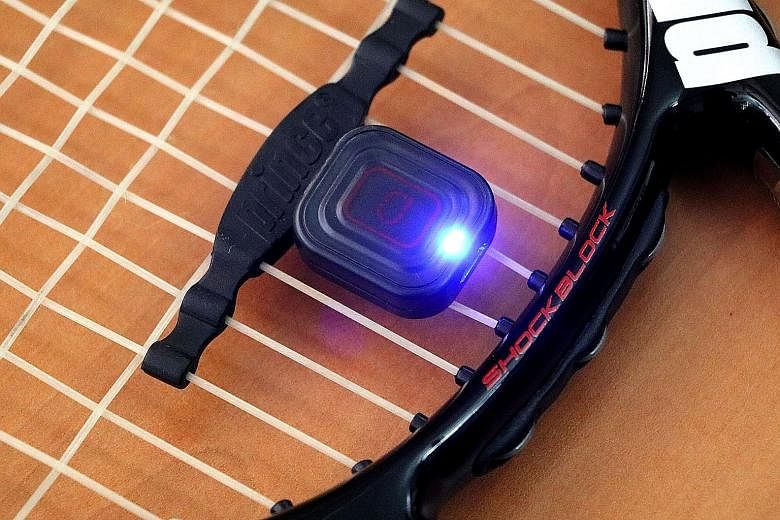The Qlipp is a tennis performance sensor that keeps track of your stroke type, swing speed, ball spin type (top spin or slice), and whether you are hitting the sweet spot - the dead-centre of your tennis racquet - during a match.
Developed by local startup 9 Degrees Freedom and crowdfunded in Indiegogo, the Qlipp is a small squarish device about the size of a dollar coin. It attaches to the strings of a tennis racquet close to its throat.
It works as a dampener to control string vibrations as well. Thus, the Qlipp can be used on any tennis racquet (and when you swap or change racquets), unlike the Babolat Smart Tennis Racquet in which the sensor is located inside the handle.
You charge the Qlipp via a micro-USB port at the base of the device and a full charge should last around four hours.
The Qlipp does not have any internal memory, but transmits the data it collects to its smartphone app (available for Android and iOS) via Bluetooth in real time. Apple Watch users can view time elapsed of the match, the speed of the last shot and current heart rate on their watch.
-
TECH SPECS
-
PRICE: $179, available on qoo10.sg
CONNECTIVITY: Bluetooth
WEIGHT: 8g
-
RATING
-
DESIGN: 4/5
PERFORMANCE: 4/5
VALUE FOR MONEY: 4/5
OVERALL: 4/5
I recommend watching the tutorial videos found in the app before attaching the Qlipp to the racquet. If not, you might damage the racquet strings. The process is not as easy as the advertised "twist and lock" installation.
You need to make sure the micro-USB port faces down and that the Qlipp logo is upright when installed. Place it in-between the strings. Twist it until one of the knobs hits a string. Finally, push the next string down in order for the second knob to catch it.
I would have preferred to leave Qlipp on the racquet but that wasn't possible, as the charging cable could not reach the Qlipp while it was attached to my racquet. To charge, I have to detach it (by reversing the steps of the attachment process).
But once installed, the Qlipp is really secure. No worries about it being flung out.
Start a session by pressing on the Qlipp logo and wait for the blue light to come on. Make sure the Qlipp app is linked to the device and you can start playing.
Data on your tennis sessions is displayed in a very user-friendly manner on the app. You get to see your consistency level in hitting the sweet spot. The percentage of your forehands, backhands and service are broken down into percentages in a nice pie chart.
You can also filter the stroke types you want to see, and get the stats on how close you were to the sweet spot and the spin type in each stroke.
The data made me realise that my fastest forehand speed was a miserable 90kmh, whereas professionals easily hit around 160km per hour.
The app also stores every session and allows you to compare each one with your previous sessions to see if you are making improvements.
In addition, you can make a video recording of your shots with the Qlipp app and your smartphone. You can even slow down the videos, which is a great way to know what went wrong with your strokes.
On the downside, the Qlipp tends to capture serves as forehands. I was sure I didn't serve five times in a game. Thanks to the video recording function, I was able to verify that the captured information was wrong.
Trevor Tan
• Verdict: For tennis enthusiasts looking to up their game, the Qlipp is a great tool to analyse and improve your tennis skills.


